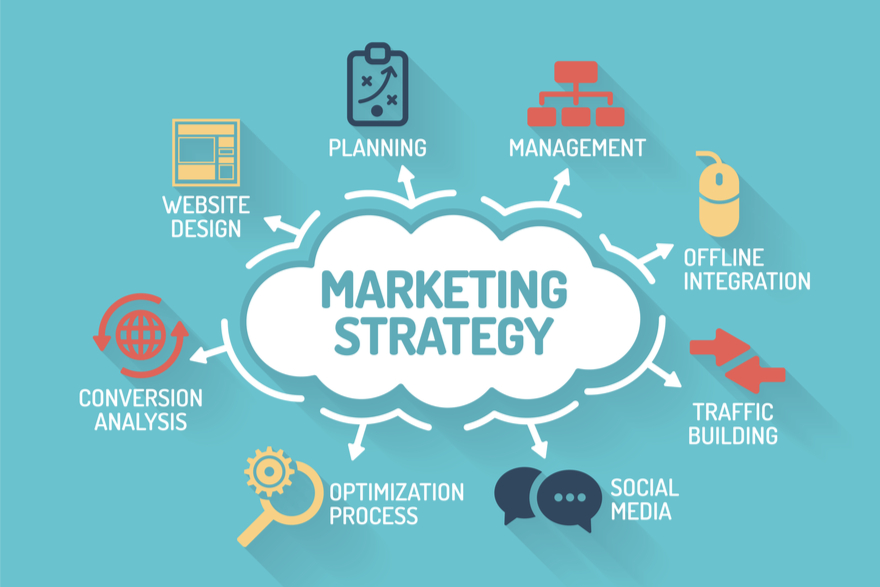Executing a marketing strategy sets your company apart from your competitors. You design tactics and implement tools to attract and build relationships with targeted customers based on the strategy. When strategy, tactics and tools are aligned, your marketing establishes healthy expectations in specific customers’ minds about your brand’s ability to satisfy their needs in ways that competitors can’t match.
Strategy
As a marketing manager, you are responsible for the company’s marketing strategy. Strategy is important because it guides your marketing decisions. Strategy involves determining which customers the company wants to target with marketing activities.
Marketing strategy involved defining your target customers’ life stages and/or motivating factors, as well as defining their needs.
To better understand your customers, engage in primary research – the qualitative methodology of hands-on research to understand human behavior. Look for secondary research, such as questionnaires, that will help you to identify your customers’ needs, wants, desires and motivations.
Don’t be afraid to ask your customers questions about their behaviors and attitudes. Customers want to feel empowered to help your company. They will be more willing to respond when given the chance to play a role in the marketing process.
Your company may have a Marketing Plan in place. Even if your company does not, your marketing strategy could include elements that fall into the marketing plan structure.
- Chapter 1 of the marketing plan could include the objectives for the following year.
- Chapter 2 could contain the strategies to achieve the objectives.
- The company’s marketing tactics – the activities, messages, symbols and methods – fall into Chapter 3, Tactics.
The last chapter in the marketing plan is Chapter 4, the promotional tools. Promotional tools generally refer to communications methods, such as advertising, marketing collateral, packaging, sales promotions and corporate actions.
Marketing strategies are based on a larger company strategy. Companies typically have multiple strategies – marketing, business strategy and corporate strategy, for example. In combination, the strategies work together.
Tactic
Tactics are action steps your company takes, such as advertising, direct mail, public relations and endorsements, to achieve the marketing strategy.
The marketing manager develops the marketing tactics to execute the company’s communication programs. Tactics influence buyer behavior. They include “every day” efforts, such as customer service and the way employees treat customers. Tactics also include the way your company engages in communications with customers.
To determine which tactics to use in your communication plans, begin with the company’s overall marketing objectives and strategies. Next, determine whether customers who purchase your company’s products or services require a different set of tactics.
There are dozens of tactics available to you. The key is to determine which ones are most effective in your industry.
Companies use tactics to build marketplace relationships. A relationship is an important part of your brand’s strategic positioning.
Tactics can be used to draw attention to your online marketing efforts, for example. Examples include:
• press releases,
• blogs and social media posts,
• Google+ pages,
• email campaigns,
• provide special offers,
• create a community group,
• speaking engagements,
• reviews and testimonials,
• articles online and in print,
• online comments,
• reviews on community sites,
• special events,
• social media (Facebook, Instagram, Twitter),
• videos (YouTube),
• podcasts,
• QR codes,
• and more.
Promotional Tools
Promotional tools are used to establish a brand in the marketplace as well as build relationships with customers. Communications efforts are often executed through promotional tools.
Strategic promotional tools are used to build community, friendship and trust. Examples include shopping cart messages, pop-up messages, and banners.
The promotional tools we use to reach customers should be appropriate for their age or stage in life. More youthful prospects may respond well to a different messaging strategy than mature prospects.
Promotional tools can be used to accomplish any of the following:
Building relationships with customers – by staying in constant contact with your customers, you can strengthen your relationship with them. Examples include newsletters and online customer communities.
• Building an online community for your customers. Examples include video testimonials, discussions, and polls.
Establishing your company as “thought leaders.” Examples include posts on your website, videos, and podcasts.
• Creating an online magazine for your customer to read.
• The marketing manager can help the company’s marketing department to determine the most effective promotional tools for building relationships with customers.
• Some of the most popular and effective online promotional tools are
Podcasts. Simple to produce, podcasts create opportunities to reach prospects and customers by providing valuable information.
Images, videos, and animations. Images can be used as an alternative to text, and as engaging elements to include in newsletters. Graphics help people see, imagine, and understand key points. Businesses should be using key graphics, such as logos, in their online marketing efforts to build relationships with customers.
Audio recordings. Audio-visual resources, such as videos, can help explain what is happening or why.
Social media. Facebook, Twitter, Instagram, and LinkedIn are excellent platforms for engaging in online conversations. A business can share information and news about its company in a spontaneous or planned way with social media followers.
Examples of promotional tools include:
• Happy birthday greetings. Unlike traditional greetings, this consists of an online screen that appears during the customer’s birthday. This message enables the company to tell the customer in an online greeting that they hope this is a happy birthday and to celebrate by making a purchase.
• Welcome banner. A business can create a preset banner on its website that appears when new visitors come to the site.
• Pop-ups. Pop-ups create an opportunity to get the customer’s attention.
• Marketing blogs. Marketing blogs are created for specific purposes, such as informing customers about new products or services, improving customer service, helping customers make informed buying decisions, encouraging them to try something new, or reassuring them that the business cares about their needs.
• Newsletters. Newsletters can be sent on a monthly or quarterly basis. Some businesses send newsletters several times a year.
• Online coupon. An online coupon is like the coupons you find in the Sunday newspaper inserts. You can send the coupons to prospective customers. Businesses can either encourage customers to print out the coupons, or provide a link on their website that the customer can click to receive the coupon.
• Supplemental content. Supplemental content is useful to primary content on websites, such as included video and audio files. Supplemental content can supplement written content on a website, too.
• Live chat. Live chat provides prospects with the opportunity to ask questions about the company’s products and services – 24 hours a day, seven days a week.
• Banner ads. Banner ads offer an opportunity to promote products or services online.
• Social media. Facebook, Twitter, Instagram, blogs, and LinkedIn provide an opportunity to connect with customers via social media.
• Internet ads. Online ads are a popular medium to reach an online audience. You can target your ideal customer more precisely with internet ads than with other forms of advertising.
• Online videos. Marketing videos provide an opportunity to reach your target audience.
• QR codes. QR codes are used to link mobile users with marketing materials.
• Widgets. Widgets are small apps that perform a specialized function, such as providing saving advice or displaying images.
• Social communities and forums. Popular social community sites include Facebook, Pinterest, forum sites, blogs, and information-sharing sites, such as Quora.
• Social media posts. You can write a Facebook post, tweet, or LinkedIn update to reach a target audience.
• Online networking. Examples include LinkedIn and personal blogs.
• Website videos. Videos created on websites are a great way to attract attention to your brand. You can use videos on your website, as well as in online marketing campaigns.
• Podcasts. You can provide a podcast on your website so people can listen to it.
• Coupons. You can offer coupons that are pretty much self-promotions. You can offer the coupon before a purchase or when the customer comes to the website.
Online Promotions
Online promotions are the tools we use to gain new customers or raise awareness of our business. Online promotions are often free, or very low cost. Examples of online promotions include:
• Advertisements on Google, Bing, and Yahoo.
• Promotions on Facebook, Instagram, YouTube, and Pinterest.
• Discounts or special offers for their customers.
• Videos that appear on tube sites.
• Buying or selling advertising space on news sites.
• Selling of keyword advertising slots on search engines.
• Banners or ads on affiliate websites.
• Negative reviews have a profound effect on your business’s online reputation – in addition to hurting your business. But your company can recover from negative reviews, and the sooner you recover the better.
Tactics:
- Respond quickly to negative reviewers. Make sure you respond quickly to any negative reviews. No matter how insignificant you think the review is, respond to it.
- Apologize and thank the reviewer. The point of responding is not to argue or defend yourself, but rather to apologize and explain what you will do next time to prevent such a situation arising again.
Promotion of your brand using promotional tools is the lifeblood of your business. Keep your communications efforts fresh and interesting, so that you attract people to your brand. Sometimes, simple is better. As you experiment and try various promotional tools, your choices will improve and the effectiveness of your promotional tools will increase.
















